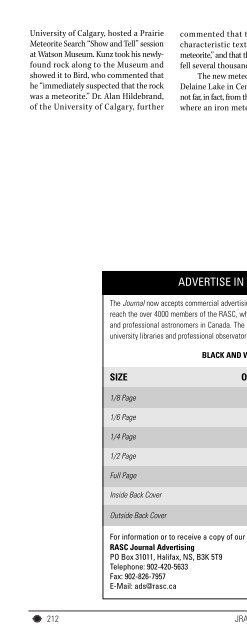I N S I D E T H I S I S S U E
insidethisissue - The Royal Astronomical Society of Canada
insidethisissue - The Royal Astronomical Society of Canada
- No tags were found...
You also want an ePaper? Increase the reach of your titles
YUMPU automatically turns print PDFs into web optimized ePapers that Google loves.
in diameter would be melted at the sametime. Or, shrinking the same amount ofice down to the surface of the sun, wecan calculate that an area ten thousandtimes the area of the earth’s surface andabout half a kilometer (0.3 mile) thickwould also be melted in 40 minutes bythe energy pouring out of the sun.In this section, we shall discuss hownineteenth-century scientists tried todetermine the source of solar energy,using the solar age as a clue.A. Conflicting Estimatesof the Solar AgeThe energy source for solar radiation wasbelieved by nineteenth-century physiciststo be gravitation. In an influential lecturein 1854, Hermann von Helmholtz, aGerman professor of physiology whobecame a distinguished researcher andphysics professor, proposed that the originof the sun’s enormous radiated energy isthe gravitational contraction of a largemass. Somewhat earlier, in the 1840’s, J.R. Mayer (another German physician)and J. J. Waterson had also suggested thatthe origin of solar radiation is theconversion of gravitational energy intoheat. 1 Biologists and geologists consideredthe effects of solar radiation, while physicistsconcentrated on the origin of the radiatedenergy. In 1859, Charles Darwin, in thefirst edition of On The Origin of the Speciesby Means of Natural Selection, made acrude calculation of the age of the earthby estimating how long it would takeerosion occurring at the current observedrate to wash away the Weald, a great valleythat stretches between the North andSouth Downs across the south of England.He obtained a number for the “denudationof the Weald” in the range of 300 millionyears, apparently long enough for naturalselection to have produced the astoundingrange of species that exist on earth.As Herschel stressed, the sun’s heatis responsible for life and for most geologicalevolution on earth. Hence, Darwin’sestimate of a minimum age for geologicalactivity on the earth implied a minimumestimate for the amount of energy thatthe sun has radiated.Firmly opposed to Darwinian naturalselection, William Thompson, later LordKelvin, was a professor at the Universityof Glasgow and one of the great physicistsof the nineteenth century. In addition tohis many contributions to applied scienceand to engineering, Thompson formulatedthe second law of thermodynamics andset up the absolute temperature scale,which was subsequently named the Kelvinscale in his honour. The second law ofthermodynamics states that heat naturallyflows from a hotter to a colder body, notthe opposite. Thompson therefore realizedthat the sun and the earth must get colderunless there is an external energy sourceand that eventually the earth will becometoo cold to support life.Kelvin, like Helmholtz, was convincedthat the sun’s luminosity was producedby the conversion of gravitational energyinto heat. In an early (1854) version ofthis idea, Kelvin suggested that the sun’sheat might be produced continually bythe impact of meteors falling onto itssurface. Kelvin was forced by astronomicalevidence to modify his hypothesis andhe then argued that the primary sourceof the energy available to the sun was thegravitational energy of the primordialmeteors from which it was formed.Thus, with great authority andeloquence Lord Kelvin declared in 1862:That some form of the meteorictheory is certainly the true andcomplete explanation of solarheat can scarcely be doubted,when the following reasons areconsidered: (1) No other naturalexplanation, except by chemicalaction, can be conceived. (2) Thechemical theory is quiteinsufficient, because the mostenergetic chemical action weknow, taking place betweensubstances amounting to thewhole sun’s mass, would onlygenerate about 3,000 years’ heat.(3) There is no difficulty inaccounting for 20,000,000 years’heat by the meteoric theory.Kelvin continued by attackingDarwin’s estimate directly, askingrhetorically:What then are we to think ofsuch geological estimates as[Darwin’s] 300,000,000 years forthe “denudation of the Weald”?Believing Darwin was wrong in hisestimate of the age of the earth, Kelvinalso believed that Darwin was wrongabout the time available for naturalselection to operate.Lord Kelvin estimated the lifetimeof the sun, and by implication the earth,as follows. He calculated the gravitationalenergy of an object with a mass equal tothe sun’s mass and a radius equal to thesun’s radius and divided the result by therate at which the sun radiates away energy.This calculation yielded a lifetime of only30 million years. The correspondingestimate for the lifetime sustainable bychemical energy was much smaller becausechemical processes release very littleenergy.B. Who was Right?As we have just seen, in the nineteenthcentury you could get very differentestimates for the age of the sun, dependingupon whom you asked. Prominenttheoretical physicists argued, based uponthe sources of energy that were knownat that time, that the sun was at most afew tens of millions years old. Manygeologists and biologists concluded that1 von Helmholtz and Mayer were two of the codiscoverers of the law of conservation of energy. This law states that energy can be transformed from one formto another but the total amount is always conserved. Conservation of energy is a basic principle of modern physics that is used in analyzing the very smallest(sub-atomic) domains and the largest known structure (the universe) and just about everything in between. We shall see later that Einstein’s generalizationof the law of conservation of energy was a key ingredient in understanding the origin of solar radiation. The application of conservation of energy to radioactivityrevealed the existence of neutrinos.220JRASC December / décembre 2000
















